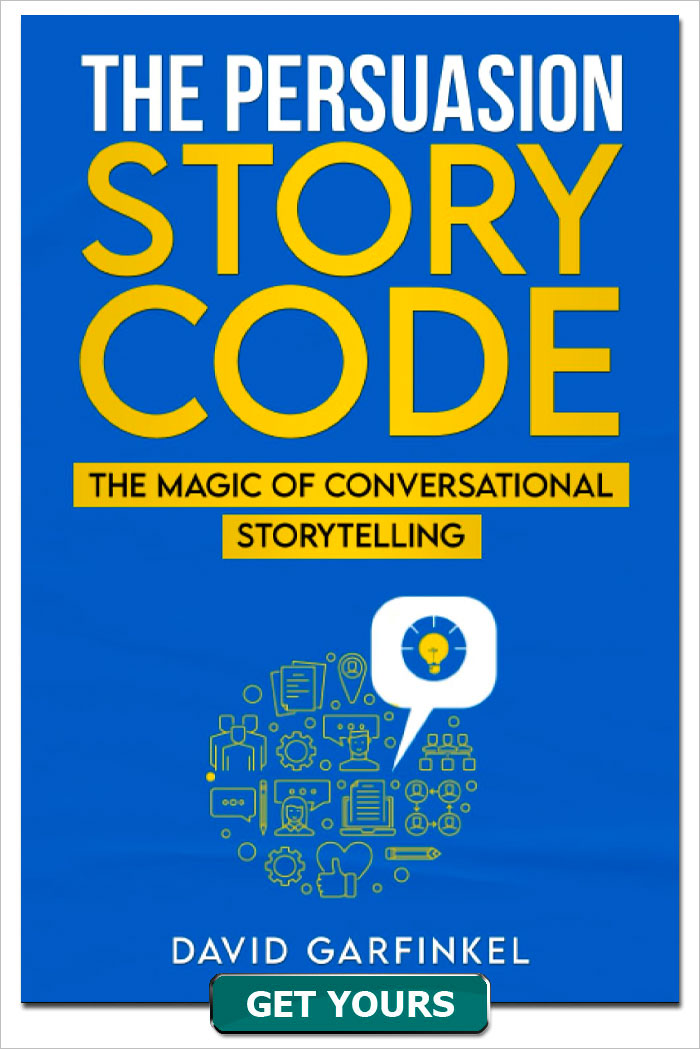Episode 057 -The Secret of Instant Understanding
Published by: David Garfinkel on 05-21-2018
Tweet
My girlfriend has a dog named Sheila, and Sheila’s an Australian Shepherd.
Now, Australian Shepherds are working dogs and they always seem to need to have a job to do.
Last Tuesday, Deb was sitting down to write some copy on her computer and she told me that Sheila was guarding the door for her.
I thought that was interesting. Sheila didn’t know what to do, but she figured out Deb didn’t want to be disturbed. So, Sheila gave herself the job of guarding the door.
Smart dog!
OK, I’m telling that story to give a shout-out to Sheila. But also to show you something that today’s show’s about: How you can get instant understanding and have people remember more of what you say by communicating in images.
You may not remember the whole story I told you, but I bet you understood the idea of a dog guarding the door while a writer was busy writing, and I bet you won’t have a hard time remember it.
Why?
Because those words, “Sheila was guarding the door for her,” creates a clear, simple imagine in your mind. Dog, door, woman, computer, writing. Simple!
This is important for more than the fact that I feel good about Deb being protected when I’m not with her. Because in addition to everything else, Sheila is fierce.
It’s also important because today’s show is about getting people to understand you instantly and remember more of what you say. And that’s what we’ll talk about today.
First, I would like you to instantly understand this:
Copy is powerful. You’re responsible for how you use what you hear on this podcast. Most of the time, common sense is all you need. But if you make extreme claims… and/or if you’re writing copy for offers in highly regulated industries like health, finance, and business opportunity… you may want to get a legal review after you write and before you start using your copy. My larger clients do this all the time.
The image-word / word image cycle
This is a simple way of looking at how our minds work that I’ve never heard of or seen anywhere else. I think it’s right and I know it’s powerful.
Gene Schwartz concept in The Brilliance Breakthrough
Here’s his idea: The mind thinks in images, and then it decodes images into words. And when you hear words, it encodes the words back into images. If you can use words to create images, people will have the “coding” work already done for them. They will understand you much faster, and remember what you tell them.
Direct quote from the book:
“Why do we memorize images instead of words? For a very good reason: One image can be memorized as easily as four or six or eight or even ten words. So instead of storing ten separate facts at once I our memory, we have to store only one.”
“Understanding is therefore image-sharing. When you and another person understand each other, you share the same images. When the two of you talk about the same things, you both see the same things. When the two of you talk about doing the same actions, you both see how to do those actions.
“You have – on that subject, in that area – common minds. You think alike. And that is what communication is all about.”
Why this is important
The more quickly, easily, and directly you communicate images in your copy, the more people reading your copy will end up buying.
Some great examples
This is one show where it’s actually better to hear the examples than to read them. You’ll get more of the visual/image/instant effect as I read these to you.
1) A sentence from my critiques page on garfinkelcoaching.com
“I’ve just given you a solid roadmap to begin critiquing your own copy.”
Compare to a non-image rewrite of the same sentence:
I’ve just given you a set of steps you can use to critique your own copy.
N
t terrible – but not as instantly understandable or as memorable.
This is much better: ““I’ve just given you a solid roadmap to begin critiquing your own copy.”
2) Joe Karbo, in one of his “Lazy Man’s Way To Riches” newspaper ads: He’s talking about his life after learning direct marketing, where he works only when he wants to. He says half of the time he’ll work 5 or six hours a day.
“But about half the time, I decide to read, go for a walk, sail my boat, swim, or ride my bike.”
You can just see that… and imagine the life of leisure, and choice, he’s describing.
Compare that to this sentence, which I wrote as a non-visual example:
But about half the time, I’ll engage in recreational activities. They’re usually outdoors and they involve exercise. But they’re fun.
Kinda dull, by comparison, right. Not as powerful as:
“But about half the time, I decide to read, go for a walk, sail my boat, swim, or ride my bike.”
3) Hemingway, The Old Man And The Sea:
“He was shivering with the morning cold. But he knew he would shiver himself warm and that soon he would be rowing.”
Now let’s butcher us up some Hemingway:
It was morning and the temperature was low. He was just going to have to deal with it. Soon he would be getting some exercise to start his day.
That’s not Hemmingway – that’s boring mediocre. Nothing like:
“He was shivering with the morning cold. But he knew he would shiver himself warm and that soon he would be rowing.”
4) Headline from John Carlton ad:
“World Famous Street-Fighter will give you a FREE GUN…
Just to Prove He Can Take It Away From You Bare-Handed As Easy As Candy From A Baby!”
I’m not going to even try to mess with that. Sometimes, you just don’t want to mess with perfection. Maybe I’m just superstitious, but I don’t want to touch it!
Still, let’s hear it again and see why it works so well:
“World Famous Street-Fighter will give you a FREE GUN…
Just to Prove He Can Take It Away From You Bare-Handed As Easy As Candy From A Baby!”
You can see it in your mind, can’t you? And it’s so good, it’s pretty hard to un-see it.
5) Joe Sugarman “Laser Beam Digital Watch” headline:
“Never press another button, day or night, with America’s first digital watch that glows in the dark.”
Now this is 42 years ago. I’m not going to rewrite it. Just let me read it again and see if it kinda shows up in your mind
“Never press another button, day or night, with America’s first digital watch that glows in the dark.”
You can see it, can’t you? You instantly understand, and if that’s something you’re interested in, you’ll remember a digital watch that glows in the dark!
OK, that wraps it up. Look for opportunities to express ideas as simple, powerful descriptions of images. It will make your copy easier to read, more exciting, and it will work better.
What I shared with you is a small part of one of sixteen chapters. The Brilliance Breakthrough is a book that will open up your writing and maybe even change your life.
I got my copy 15 years ago from Gene Schwartz’s widow Barbara. Then it went out print. Now Brian Kurtz has brought it back on the market and I highly recommend it. It’s not cheap, and it’s worth every penny… and then some.
You can find it on at brilliancebreakthroughbook.com.
We’ll put that in the show notes, too.
Keywords: images pictures copywriting









